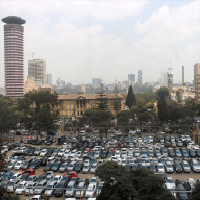By CPA David Mutoro Busaule
Counties should enhance compliance and service delivery to their citizen’s. Parking fees is a substantial source of Own Source Revenue (OSR) for urban and semi-urban devolved units like Nairobi, Mombasa, Kisumu, Nakuru, Uasin Gishu, Nyeri, Kiambu etc. For rural counties with scattered urban areas and market centers parking fees still has a huge potential to increase their share of the respective county’s OSR if well managed.
For both urban and rural counties, there still exists the substantial potential to increase the collection of parking fees if proper strategies are deployed to enhance the efficiency of the collection, reporting, projection, oversight, and enforcement processes.
For urban counties, the unrealized revenue from the levy gap from parking could be as high as 30-40% and for rural counties, this could go as high as 70% thereby denying the counties the much-needed revenue to improve service delivery to the citizens and support other development projects.
The unrealized revenue from parking fees for counties that had reported data on parking fees was as high as 61% translating to about Kshs 7.686 Billion of unrealized revenue in the FY 2016/2017 as per a report commissioned by the World Bank on behalf of the National Treasury.
The share of OSR to the total revenue for all the counties has been declining since 2015 thereby increasing the reliance by county governments on allocations from the national government as their main source of revenue for both recurrent and development expenditure.
The strategies to increase the collection of parking fees will be based on the following overarching objectives.
1. Need to enhance the levy base.
2. Need to enhance compliance through effective data-driven monitoring, surveillance, oversight, and enforcement.
3. Need to entrench an effective performance management culture, continuous business process improvement, accountability, transparency, and integrity of the collection and reporting process of parking fees.
4. Need to optimize the OSR within the existing rules of Public Finance Management (PFM) and Article 175(b) of the Constitution.
5. Need to ensure secure parking areas for all citizens.
The share of OSR to the total revenue for all the counties has been declining since 2015 thereby increasing the reliance by county governments on allocations from the national government as their main source of revenue for both recurrent and development expenditure.
The following strategies will assist devolved units like Nairobi County to achieve an increased, optimum, and sustainable collection of parking fees both in the short term and long term.
I. Mark all parking spaces/slots to ascertain the total number of parking spaces in Nairobi County (CBD, Westlands, Upperhill, Industrial area and all the suburbs and estates where parking is chargeable. Establish a framework to add more parking slots as and when they become available.
II. Register all PSVs (Matatus, Buses, Taxis) and Boda Bodas(motorbikes) loading bays and restricted parking in the county.
III. Assign unique parking numbers to each slot. If parking on Moi Avenue, then have a unique number like MA0001, if on Harambee Avenue then HA0110 should be a mandatory field when making payments. In case you move from one section to another, you should update the same through the USSD without making further payments so the system can update the available parking slots again and allow an inquiry of the parking.
IV. Enhance the payment process through both the web and USSD functionalities to drill down further e.g if a user selects CBD, option one is narrow down to Parliament road and enter the parking slot number or option two is a user does not select the area like CBD without narrowing down to the street and enter the unique parking slot number, system will be able to know you have parked on parliament road (this will avoid parking on pavements and other restricted corridors and common spaces within the county). The system will already have all the available parking slots in different areas and a real-time report can be available real time. This can enable anyone looking for parking to query the available parking spaces available at a given location through the USSD functionality hence enhancing the transparency of the overall parking process, eliminate cartels, reduces aimless driving within CBD looking for parking.
Given that the demand of parking in Nairobi especially in CBD, Upperhill, Westlands, Industrial area etc exceeds the supply, it is expected that in certain areas the county will collect more parking fees than the number of slots because of short term parking (Someone comes to run a few errands in town or industrial area for about 3 hours or so and leaves yet parking had already been paid for and another person comes later and parks at the same place and pays parking again).
V. Enhanced surveillance and oversight using license plate recognition soft ware where part of the enforcement/oversight team will be moving around the city with a gadget picking the images of all parked cars and relaying the same back to the central team through the recognition system. Once relayed, the system will flag any vehicle and send a message to the vehicle owner to pay parking within 15 minutes if the same vehicle number has ever been parked in Nairobi. If parking remains unpaid the clamping team is notified through an SMS alert indicating where the vehicle is actually parked. The clamping teams will be stationed in different parts of the county and will be randomly assigned duties to avoid familiarity and collusion with parking attendants, parking boys, and vehicle owners. This oversight can be random and done at least twice a day (Morning hours and Afternoon). There will also be targeted monitoring of those areas where there is a huge variance between parking slots paid for and number of available parking slots.
VI. A daily report to be generated at close of business/midnight on all the collections received, how many vehicles were parked in Nairobi and how many parking slots were utilized broken down per street, ward, constituency, Sub County etc. This report will also form part of the performance management reports for each parking attendant.
VII. Automate any Nairobi County Parking space e.g Sunken, space next to Kenya RE on Taifa road and align them to best practices including installation of licence recognition soft ware and parking management system to enhance collections.
VIII.Assign targets to parking attendants as per the parking slots under their area of jurisdiction.
IX. Assign targets to enforcement officers as per the inconsistency reports generated by system.
X. Have an independent oversight team to monitor this new process to enable continuous business improvement and sustainability before hand over to the county
XI.Enter into partnerships with the private sector and donors to develop parking spaces in prime parcels of land owned by Nairobi County to bridge the gap between demand and supply of parking space in the county.
XII. Automate all PSV stages and Taxi parking bays to ensure any vehicle entering such designated spaces has paid the respective parking charges and where parking is not paid then a notification alert is relayed to the enforcement team.
XIII. Request for data from other respective government agencies to complement the collection of parking fees e.g Data from Insurance companies on all PSVS, Data from NTSA on all vehicles registered as commercial PSV, Data from KRA on all vehicles who have paid advance tax, Data from all PSV SACCOS operating in Nairobi County or whose destinations of some of their vehicles is Nairobi County.
XIV. Address any legislation gaps if any affecting collection of parking fees especially in areas that may not be leasehold properties or other legal challenges exist which may inhibit collection of parking fees.
XV. Consider usage of drones to enhance parking compliance in downtown and the outskirts.
XVI. Enable online payment for fines relating to parking offenses and swift removal of the clamp from the car. This may require each clamp to be uniquely marked to a given street so that the payment can be mapped to the clamped vehicle location and a notification sent to the enforcement team to remove the clamp.
XVII. Provide an opportunity for those who have exited early to report the parking slot as available through USSD and Mobile App functionalities.
XVIII. Consider a parking reward scheme where your wallet/account gets a discount on your next parking if you exit early and you had reported the parking slot as available and someone else parks at the same slot and pays parking too.
XIX. Have a structured engagement with parking boys and organize them informal groups so the county partners with them in ensuring the security of all the parked vehicles and other enforcement activities at a predetermined cost. With the increased OSR arising from parking fees, counties like Nairobi in conjunction with the National Government should install more CCTVs covering parking areas to deter breakages and theft of valuables left in the cars and establish a covert surveillance team deployed in areas with persistent cases of break- ins and theft .
Enhancing OSR capabilities for devolved units will require them to adopt radical steps to entrench a high-performance organization culture to enhance the delivery of efficient public services to mwananchi. Counties are required to re-engineer the processes, procedures, update their legislations and by laws, digitize and automate their end-to-end processes relating to management of all types of OSR, continually adapt and improve their processes to enable them to achieve their goals of fi scal independence and to enhance compliance and service delivery to their citizens.
The writer is a Certified Public Accountant, Business Process Reengineering and Improvement Specialist and Own Source Revenue Enthusiast and Specialist. Email: [email protected]




